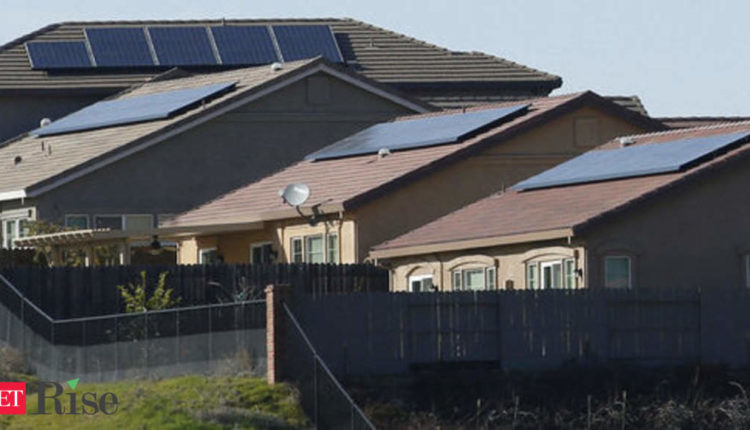Solar inverters: how do they work, their varieties and makes use of – Financial Occasions
In times of an environmental crisis where ever greener and more sustainable means of generating electricity must be used, installing solar panels and inverters to generate electricity is one of the best ways to help improve the environment.
What are solar inverters?
A solar inverter is one of the most important elements of a solar system. It enables the conversion of direct current (DC) to alternating current (AC), making the energy usable for a variety of residential, commercial and industrial applications, e.g. B. for powering various instruments, from commercial to normal household appliances such as refrigerators. Televisions and microwaves to huge industrial plants. Not only do solar inverters play a vital role in applying green energy to most electrical appliances, they also help monitor the performance of the entire solar system and provide diagnostic data necessary to identify and correct technical errors. In addition, users can use inverters to store excess energy in batteries or feed it back into the main power grid.
Role of solar inverters in solar PV systems
A solar inverter primarily plays the following role in a solar system:
- Conversion of direct current into alternating current
- Maximizing energy production
- Ensuring safe system operation
- Improved network support functions
- Efficient tracking of power delivery
Applications and advantages of different types of solar inverters
The suitability and application of different types of solar inverters depends on a number of criteria. Below are several types of solar inverters available in India along with their uses, benefits, and other important details:
String inverter
They are connected directly to the mains and usually do not have a battery fuse. These are the most common solar inverters used for business and household purposes. They usually have a lifespan of 25 years and a 5 year guarantee.
Applications
This type of inverter is suitable for both private and commercial purposes as they cover the area of small utility systems, which generally fall below 1 MW. String inverters are best for homeowners looking for lower-cost PV systems or properties with uncomplicated roofs that receive consistent sunlight throughout the day.
benefits
- Reliable technology
- Easiest to maintain as they are installed in easily accessible places
- Availability of 3 phase options
- Pocket friendly
- Very efficient
- Lower installation costs as no special tools or equipment are required
- High design flexibility
- Energy efficient
Central inverter
These solar inverters are highly efficient and at the same time compatible with certain features of the grid – fluctuation management, balancing etc. This type of solar inverter is generally very large and has its own storage room, its own exhaust system etc. They are generally available with an output of 400 KW or more.
Applications
Central inverters are generally used for large commercial systems, industrial systems or solar parks on a supply scale, since central inverters support a consistently uniform and uniform production. They are generally not preferable for residential use as their much smaller counterpart – string inverters – is sufficient to meet household energy needs.
benefits
- Centralized control for easy management
- Optimized costs per watt
- Very efficient
- easy installation
Micro inverter
As the name suggests, they are relatively smaller in size and capacity when compared to string inverters and generally have a capacity in the 200-350W range. They are comparatively more expensive, yet more effective for areas with partial shading. They are installed individually on the back of each panel so that the changeover from DC to AC occurs for the particular panel to which it is connected.
Applications
These are best for residential and commercial buildings where the solar panels are facing in different directions, thereby combating inefficiencies caused by shading. It is more expensive than string inverters, but the perfect solution for installations where the solar radiation of individual solar modules is different.
benefits
Higher solar energy production
Fights shadow problems
Most suitable for solar panels in different directions
Usually offered with a 25 year guarantee
Traceability of each panel individually
Off-grid inverter
They are also known as standalone inverters as they are completely independent of syncing with a solar panel. Off-grid inverters receive energy to convert batteries, which are charged with the help of photovoltaic arrays. This type of solar inverter is most commonly used in remote areas where people want to live entirely off the grid.
Applications
Off-grid inverters are best for remote or rural areas where the utility grid is far from the solar inverter and connecting the inverter to the utility grid would be impractical and uneconomical.
benefits
- Self-supporting energy system without connection to a power grid
- Pocket friendly
- Easily installed in rural areas where the grid is located far away
- Works regardless of shutdowns or power failures
- Reliable thanks to power storage in batteries
In India the prices for different solar inverters vary depending on the type, phase and capacity. The capacity of off-grid inverters generally varies between 500 VA and 50 KVA and is available in various phase options from 12 V / 1 phase to 360 V / 3 phase. Their cost typically varies between Rs 3500 and Rs 3,20,000.
Grid-connected inverters
It is a solar inverter that is able to feed the converted energy into the main power grid by adjusting the appropriate phase and frequency. For safety reasons, these inverters can also be switched off automatically when they are connected to the supply network.
Applications
They are best suited for homes and offices in urban areas that have access to electrical outlets and wires to connect to the utility grid. Solar users who do not want to invest in batteries should opt for grid-connected inverters.
benefits
- Simple feeding of energy into the power grid
- easy installation
- Cost efficient
- Combats the high demand for electricity
The capacity of the grid-connected inverters available in India generally varies between 1 KW and 50 KW and is available in two different phase variants – single-phase and three-phase. Their cost typically falls in the range of Rs 19,000 to Rs 2,30,000.
Battery-based inverters / hybrid solar inverters
This type of solar inverter is a combination of off-grid and grid-connected inverters, as they offer you complete independence from the grid and at the same time synchronize with the grid for days with little sunlight or high power consumption. They use a technique called "DC coupling" that connects the battery to the inverter.
Applications
This type of inverter is ideal for users who want to cut costs by taking energy generated from sunlight during the day and storing it in batteries to support energy consumption after sunset. Hybrid solar inverters are the perfect choice for buyers who frequently encounter power outages, errors, and excessive load shedding.
benefits
- Reduced power consumption from the grid
- Continuity in the power supply
- Effective load management
- Low maintenance costs
- Efficient energy management, as it facilitates the use of stored energy in times of high energy demand
The capacity of hybrid solar inverters commonly available in India varies in the 3 KW to 50 KW range and has different phase options that vary between 48 V / 1 phase and 240 V / 3 phase. Their cost is typically in the range of Rs 71,500 to Rs 7,90,000.


Comments are closed.